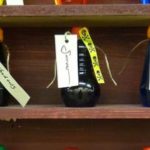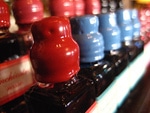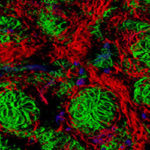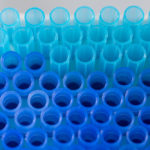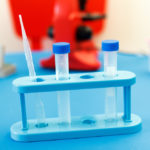Nick Oswald
After obtaining his PhD from the Dundee University School of Life Sciences, Nick Oswald moved into to industry, first working in a small team that designed Sophion Bioscience’s prototype Q-Patch system and then developing industrial bioprocesses with Ingenza Ltd.
His time at the bench gave him the feeling that a) he would like to move into writing and publishing and b) he had something to offer in helping researchers to share their professional know-how to make science more efficient, more successful, and more enjoyable to be a part of.
So while still working in the lab in 2007 he started BitesizeBio.com and began writing about what he knew himself. His first article was titled “5 DNA Ligation Tips” and was quickly followed by further articles about laboratory techniques soft skills and life skills gleaned from his experience in the lab. As researchers found his articles on Google, some came forward to contribute their expertise in articles and so began the growth of Bitesize Bio into the huge and vibrant knowledge-sharing community it is today.
Bitesize Bio became Nick’s full-time job in 2010 but prior to that, while growing Bitesize Bio, he cut his teeth in publishing and marketing with stints of work with Cold Spring Harbor Laboratory Press and the journal, Neuroendocrinology.
These days Nick is focused on the further growth and improvement of Bitesize Bio as a knowledge-sharing hub, other projects within his company Science Squared Ltd, and assisting biotech companies to market their products and services with genuinely useful educational material via Bitesize Bio and the Life Science Marketing Society.
Articles by Nick Oswald
One of the most crucial steps in any cloning procedure is the preparation of the vector. Get it wrong and your chances of success will be drastically reduced. The overall aim for a good vector preparation is to obtain a fairly concentrated stock of undamaged, fully digested plasmid DNA that is free from contaminants. Missing…
The most comprehensive way to evaluate DNA concentration and purity is to use both UV spectrophotometeric measurements and agarose gel eletrophoresis. This quick reference guide gives an overview of the information that can be derived from both. UV spectrophotometric measurement of DNA concentration and purity DNA itself, and most of the common contaminants found in…
Do you fear failure every time you do an experiment? Do you feel constantly stressed about obtaining poor results? Do you feel personally culpable when an experiment goes wrong? If you answered “yes” to any or all of these questions, you may be suffering from perfectionism. For a scientist, this is a particularly damaging trait…
You’ve tried all the usual stuff, and checked the primer sequences twice, but still can’t get that PCR fragment amplified. It’s time to enter the strange world of PCR additives. Over the years a variety of additives have been shown to enhance PCR reactions in certain situations. Here is a summary of some of the…
In the previous installment of this series on western blotting, we addressed potential sources of error when your final product is completely bare. But alternatively, what do you do when too much background is the problem? You may have beautiful bands of interest—but if there is a bunch of non-specific binding, your quantification and data…
Most of us use pretty standard transformation protocols for E.coli. Yours probably goes something like this: – Thaw the competent cells on ice – Add DNA – Electroporate (or incubate then heat shock for chemically competent cells) – Add rich medium (LB or SOC) – Incubate at 37°C (or appropriate temperature) for 30-60 minutes –…
Dear Aunt Yersinia, A very annoying postdoc in our group keeps telling me off for spinning E.coli at 13K in a tabletop centrifuge. The postdoc claims that high speed damages cytoskeleton and this will reduce my transformation frequency. But I don’t believe her as the cells are cushioned by water during centrifugation. Can you tell…
Problems with expressing your gene? One of the potential stumbling blocks in heterologous gene expression is incompatible codon usage. Every amino acid can be encoded by more than one codon, and for every amino acid each organism has a favorite codon that it tends to use more often than the others. The availability of tRNA…
Discover the different approaches to FRET quantification and get tips for selecting your FRET pairs.
My PhD is rapidly becoming a distant memory. Before nostalgia completely obscures my recollections of this chapter of my career, I thought I’d jot down some pointers for prospective and current PhD students. These are mainly based on things I wish I had done during my PhD, or mistakes I have seen others make. I…
No matter how efficient you are, it’s always possible to improve your productivity and improving your productivity means that you get more of the rewards you are trying to obtain: results, publications… or dare I say it, money. Here are 20 ways to improve your productivity. Some are focussed toward improving the productivity of bench…
We all know the traditional Christmas Eve scene of Santa flying in his sleigh through the crisp night air, pulled by his troop of reindeers. Over the years, debate has raged in the scientific community as to just how he could be pulling off this feat. We still don’t know how he does it. But…
Most of the time, research (and life!) can feel like a struggle. Constant deadlines, incessant demands, pressure to get results, grants, job, publications – and dealing with irritating colleagues and bosses. You know what I mean. The struggle saps your energy, and removes the color from your life. It reduces your capacity to focus on your…
Colocalization blues (and reds and greens) Trying to find if and where two epitopes co-localize (or, to be more precise, where they are found in close proximity) may seem easy at first: 1) Bind your two epitopes with primary antibodies from two different species, 2) bind these primary antibodies with two secondary fluorescent antibodies, one…
Dear Aunt Yersinia, I work with a yeast vector where my gene is under a Gal promoter. My boss told me to grow yeast in medium with sucrose, and then add galactose to induce the promoter. I did it, but my protein is not induced; the Western blot is empty. I sequenced a part of…
In the first part of this article (you can read it here), we looked at clipping and saturation in terms of microscope images, followed by a definition of Dynamic Range and an introduction to Bit Depth. Intrascene Dynamic Range The dynamic range which can be detected at the same time in the same field of…
We are pleased to announce that the famous maid of microbiology, dear old Aunt Yersinia, has agreed to start writing a microbiology and molecular biology advice column for Bitesize Bio. She will be free to answer your most pressing questions sent to: auntyersinia@bitesizebio.com By way of introduction, Aunt Yersinia is bestowing 8 spores of knowledge garnered…
Ever tried to turn the volume all the way up on a small radio or small stereo system? (Hopefully you have not tried it with earphones in!) Notice how, after some point, the sound didn’t get any louder- it just got more distorted? That’s because you’ve hit the ceiling of your machine’s dynamic range. It’s…
“A two photon microscope has higher sensitivity than a normal confocal microscope, because it uses two photos instead of one!” Yes, I can bear witness that this phrase has actually been uttered, and it was not by an undergraduate student. No exception to the rule The condensation of various levels of misunderstandings in this statement…
“Well, of course”- I can hear someone saying. “It can make things look as much as 200, 000 times bigger”. Problem is, the first sentence is wrong, and the second one is meaningless! On quick and thoughtless answers to simple questions I had just been admitted as an MSc student at UCL, and was attending…
To answer some of the more interesting research questions, you often need to get a good look at what’s going on inside the cell. Whether you’re running a Western blot or measuring enzyme activity, many assays require access to the materials (e.g. proteins, DNA, subcellular fragments) contained within the cell walls. There are several ways…
Whenever you make up a solution or use a purchased reagent in the lab, you trust the work of a whole army of people and equipment. If any one of those links in the chain has a technical problem or makes a mistake, then your reagent might turn out to be faulty. And that can…
RNases are like the baddie super-heroes amongst laboratory enzymes. They are omnipotent, destructive and seemingly indestructible. This is because they were created by evil overlords, for the sole purpose making life difficult for the brave scientists who battle every day to produce high quality, intact RNA preps. Ok, I’m joking about the overlords part. But…
I have been fortunate enough that in my career to date I have rarely experienced the problem of other people stealing my reagents. However, one PI told me of her experiences working in a US laboratory where things had got so bad people brought their reagents home at the weekends! Working in a research laboratory…
After years of hard work in the lab, having to sit down and write everything up can be a daunting and difficult task. Here are a few tips that I picked up during my thesis write-up that might help to make the process that little bit easier. Back up This is probably the advice most…
Working with RNA? What fun! Those little, nearly indestructible RNases are everywhere – on your skin and mucous membranes, in the water and (some of the) enzymes you use, on lab surfaces, even in airborne microbes! Here are 10 ways to keep the RNases at bay, and keep your precious samples safe:
In today’s technology-driven world, we leave so many things to our electronic gadgets. Surprisingly, many life scientists try manically to control the appearance of their documents by hand with programs like MS Word. LaTeX takes this task off your hands by providing highly efficient algorithms to properly format your texts. The results are almost always…
I’m sure you’ve heard of Parkinson’s Law, or at least the modern-day generalisation of it. It states that “Work expands so as to fill the time available for its completion.” When I first heard this, back in the mists of time, I thought Mr Parkinson was damn right, had a chuckle at a very accurate…
Site-directed mutagenesis studies can be extremely useful for elucidating the function of a gene or protein, or for creating variants of an enzyme with new and improved functions. There are now many approaches available for generating site-directed mutants, whatever your purpose. In this post I’ll summarize three techniques that will enable you to produce a…
We scientists are all so focused on getting our work published that many of us seem to forget something very important; that publication is just the beginning. After publication is when our manuscripts really have to do their essential work of communicating our science to our peers. If no-one reads the manuscript, we might as…
Here’s an all-too-often repeated scene in the lab: First thing in the morning, you approach the 37°C incubator with trepidation, open it and through one half-open eye you take a look at the LB plate that you spread your ligation-reaction-transformed E.coli aliquot onto. Looks good – thousands of colonies. Emboldened, you take your “no ligation…
Learning how to speed read can save you a bunch of time; we’ve outlined some simple steps that will dramatically improve your reading speed.
Sepharose beads are porous, which gives them a high surface area for interaction with proteins and allows them to hold a lot of liquid. This is perfect for the application that they were originally designed for: purifying milligrams of protein in columns. When immunoprecipitation (IP) – a small-scale technique for pulling specific proteins out of solution using…
Looking for a new direction in your career? This is the latest in our new series of articles that focus on careers for scientists. When we started this series, we thought you’d be interested in finding out about who does what behind the scenes at Bitesize Bio, and how we got here. I interviewed our…
Looking for a new direction in your career? Well you’ve come to the right place. This is the first in our new series of articles that focus on careers for scientists. We’ll be looking at jobs that are off-the-beaten-track (and sometimes on no track at all) and ones that are certainly not on the standard…
Coffee is powerful stuff, but did you ever think of using it for….
CIP has been around for a while, but there is a better alternative.
If you regularly grow up the same bacterial culture, whether it’s the strain that expresses your favorite protein, the culture you make your competent cells from, or just your regular control strain, it can be a bit of a pain growing it up from scratch each time. Before you even get to grow your actual…
The humble plasmid. We now know it so well, but as little as 60 years ago the field of extra-chromosomal heredity was decidedly murky. Not only was it the subject of great debate, conflict and friction within the scientific community, it was even used as a politico-religious tool during the Cold War! The origin of…
There’s something in the water, and it would love to go after your experiments. Straight out of the tap, water contains microorganisms, endotoxins, DNase and RNase, salts and other impurities that could gobble up your experiment in one bite. Of course we avoid this drama completely by using purified water from which these nasties have…


